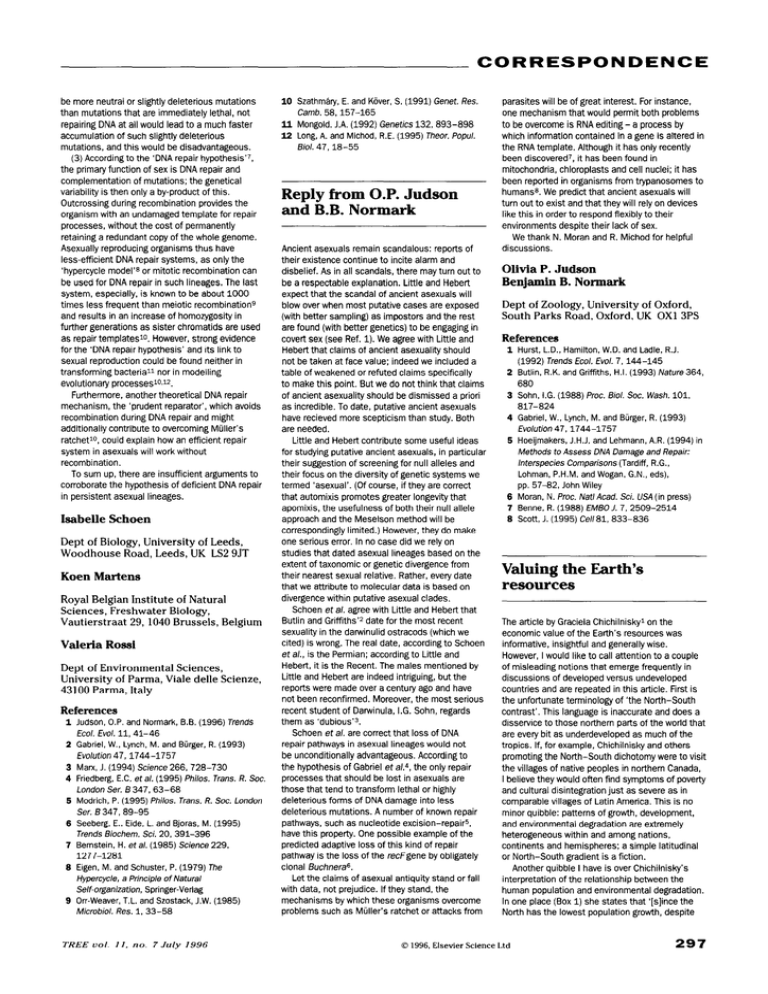CORRESPONDENCE
advertisement

CORRESPONDENCE be more neutral or slightly deleterious mutations than mutations that are immediately lethal, not repairing DNA at all would lead to a much faster accumulation of such slightly deleterious mutations, and this would be disadvantageous. (3) According to the ‘DNA repair hypothesis’7, the primary function of sex is DNA repair and complementation of mutations; the genetical variability is then only a by-product of this. Outcrossing during recombination provides the organism with an undamaged template for repair processes, without the cost of permanently retaining a redundant copy of the whole genome. Asexually reproducing organisms thus have less-efficient DNA repair systems, as only the ‘hypercycle model’8 or mitotic recombination can be used for DNA repair in such lineages. The last system, especially, is known to be about 1000 times less frequent than meiotic recombination9 and results in an increase of homozygosity in further generations as sister chromatids are used as repair templateslo. However, strong evidence for the ‘DNA repair hypothesis’ and its link to sexual reproduction could be found neither in transforming bacterial1 nor in modelling evolutionary processes10,12. Furthermore, another theoretical DNA repair mechanism, the ‘prudent reparator’, which avoids recombination during DNA repair and might additionally contribute to overcoming MOller’s ratchetlo, could explain how an efficient repair system in asexuals will work without recombination. To sum up, there are insufficient arguments to corroborate the hypothesis of deficient DNA repair in persistent asexual lineages. Isabelle Schoen Dept of Biology, University of Leeds, Woodhouse Road, Leeds, UK LS2 9JT Koen Martens Royal Belgian Institute of Natural Sciences, Freshwater Biology, Vautierstraat 29, 1040 Brussels, Belgium Valeria Rossi Dept of Environmental Sciences, University of Parma, Viale delle Scienze, 43100 Parma, Italy References Judson, O.P. and Normark, B.B. (1996) Trends Ecol. Evol. 11, 41-46 Gabriel, W., Lynch, M. and Biirger, R. (1993) Evolution 47,1744-1757 Marx, J. (1994) Science 266,728-730 Friedberg, E.C. et a/. (1995) Phi/OS. Trans. f?. Sot. London Ser. 8 347,63-68 Modrich, P. (1995) Phi/OS. Trans. R. Sot. London Ser. B 347,89-95 Seeberg, E., Eide, L. and Bjoras, M. (1995) Trends Biochem. Sci. 20,391-396 Bernstein, H. et al. (1985) Science 229, 1277-1281 Eigen, M. and Schuster, P. (1979) The Hypercycle,a Principle of Natural Se/f-organization, Springer-Verlag Orr-Weaver, T.L. and Stostack, J.W. (1985) Microbial. Res. 1, 33-58 TREE vol. I I, no. 7 July 1996 10 Szathm&y, E. and Kaver, S. (1991) Genet. Res. Camb. 58,157-165 11 Mongold. J.A. (1992) Genetics 132, 893-898 12 Long, A. and Michod, R.E. (1995) Theor. Popu/. Biol. 47, 18-55 Reply from O.P. Judson and B.B. Normark Ancient asexuals remain scandalous: reports of their existence continue to incite alarm and disbelief. As in all scandals, there may turn out to be a respectable explanation. Little and Hebert expect that the scandal of ancient asexuals will blow over when most putative cases are exposed (with better sampling) as impostors and the rest are found (with better genetics) to be engaging in covert sex (see Ref. 1). We agree with Little and Hebert that claims of ancient asexuality should not be taken at face value; indeed we included a table of weakened or refuted claims specifically to make this point. But we do not think that claims of ancient asexuality should be dismissed a priori as incredible. To date, putative ancient asexuals have recieved more scepticism than study. Both are needed. Little and Hebert contribute some useful ideas for studying putative ancient asexuals, in particular their suggestion of screening for null alleles and their focus on the diversity of genetic systems we termed ‘asexual’. (Of course, if they are correct that automixis promotes greater longevity that apomixis, the usefulness of both their null allele approach and the Meselson method will be correspondingly limited.) However, they do make one serious error. In no case did we rely on studies that dated asexual lineages based on the extent of taxonomic or genetic divergence from their’ nearest sexual relative. Rather, every date that we attribute to molecular data is based on divergence within putative asexual clades. Schoen et a/. agree with Little and Hebert that Butlin and Griffiths’2 date for the most recent sexuality in the darwinulid ostracods (which we cited) is wrong. The real date, according to Schoen et al., is the Permian; according to Little and Hebert, it is the Recent. The males mentioned by Little and Hebet? are indeed intriguing, but the reports were made over a century ago and have not been reconfirmed. Moreover, the most serious recent student of Datwinula, LG. Sohn, regards them as ‘dubious’3. Schoen et al. are correct that loss of DNA repair pathways in asexual lineages would not be unconditionally advantageous. According to the hypothesis of Gabriel et a/.4, the only repair processes that should be lost in asexuals are those that tend to transform lethal or highly deleterious forms of DNA damage into less deleterious mutations. A number of known repair pathways, such as nucleotide excision-repairs, have this property. One possible example of the predicted adaptive loss of this kind of repair pathway is the loss of the recFgene by obligately clonal Buchnerae. Let the claims of asexual antiquity stand or fall with data, not prejudice. If they stand, the mechanisms by which these organisms overcome problems such as Miiller’s ratchet or attacks from parasites will be of great interest. For instance, one mechanism that would permit both problems to be overcome is RNA editing - a process by which information contained in a gene is altered in the RNA template. Although it has only recently been discovered’, it has been found in mitochondria, chloroplasts and cell nuclei; it has been reported in organisms from trypanosomes to human+. We predict that ancient asexuals will turn out to exist and that they will rely on devices like this in order to respond flexibly to their environments despite their lack of sex. We thank N. Moran and R. Michod for helpful discussions. Olivia P. Judson Benjamin B. Nonuark Dept of Zoology, University of Oxford, South Parks Road, Oxford, UK OX1 3PS References Hurst, L.D., Hamilton, W.D. and Ladle, R.J. (1992) Trends Ecol. ho/. 7, 144-145 Butlin, R.K. and Griffiths, H.I. (1993) Nature364, 680 Sohn, LG. (1988) Proc. Biol. Sot. Wash. 101, 817-824 Gabriel, W., Lynch, M. and BBrger, R. (1993) Evolution 47, 1744-1757 Hoeumakers, J.H.J. and Lehmann, A.R. (1994) in Methods to Assess DNA Damage and Repair: lnterspecies Comparisons (Tardiff, R.G., Lohman, P.H.M. and Wogan, G.N., eds), pp. 57-82, John Wiley Moran, N. Proc. Nat/ Acad. Sci. USA (in press) Benne, R. (1988) EMBO J. 7,2509-2514 Scott, J. (1995) Cell 81,833-836 Valuing the Earth’s resources The article by Graciela Chichilniskyi on the economic value of the Earth’s resources was informative, insightful and generally wise. However, I would like to call attention to a couple of misleading notions that emerge frequently in discussions of developed versus undeveloped countries and are repeated in this article. First is the unfortunate terminology of ‘the North-South contrast’. This language is inaccurate and does a disservice to those northern parts of the world that are every bit as underdeveloped as much of the tropics. If, for example, Chichilnisky and others promoting the North-South dichotomy were to visit the villages of native peoples in northern Canada, I believe they would often find symptoms of poverty and cultural disintegration just as severe as in comparable villages of Latin America. This is no minor quibble: patterns of growth, development, and environmental degradation are extremely heterogeneous within and among nations, continents and hemispheres; a simple latitudinal or North-South gradient is a fiction. Another quibble I have is over Chichilnisky’s interpretation of the relationship between the human population and environmental degradation. In one place (Box 1) she states that ‘[slince the North has the lowest population growth, despite 0 1996, Elsevier Science Ltd 297


